The Summerland Trail on Washington state’s Mount Rainier is one of the most spectacular hikes in the national park, offering fields of wildflowers, rushing waterfalls, and jaw-dropping views of the eponymous mountain. If you’re looking to escape the mass crowds of the neighboring Sunrise portion of the park, look no further- here’s everything you need to know about the Summerland Trail.
This post may contain affiliate links. If you make a purchase through them, we may receive a small commission, for which we are extremely grateful, at no extra cost to you.

About the Summerland Trail
- Length: 10.1 miles
- Elevation gain: 2,595 feet
- Difficulty: Moderate to difficult
- Dog-friendly: Nope- like most U.S. national parks, Mount Rainier does not allow our furbabies on its trails, so you’ll sadly need to leave your best friend at home for this one.

How to Get to the Summerland Trail
The Summerland trail is located in Mount Rainier National Park, home to the famed 14,411 foot giant that holds the title of the tallest mountain in the Cascade Mountain range. Located a little less than two hours southeast of Seattle, the national park is enormous- over 230,000 acres- so be sure you’re headed to the right spot in the park.
The trailhead, located here, is near Rainier’s Sunrise section, on the northeastern side of the mountain, so you’re going to want to enter from the park’s White River entrance.
It costs $30 per vehicle for a one-week pass in the park or, alternatively, you can pick up an America the Beautiful Pass for just $80 for unlimited access for a whole year to alllll the national parks (such a steal!).
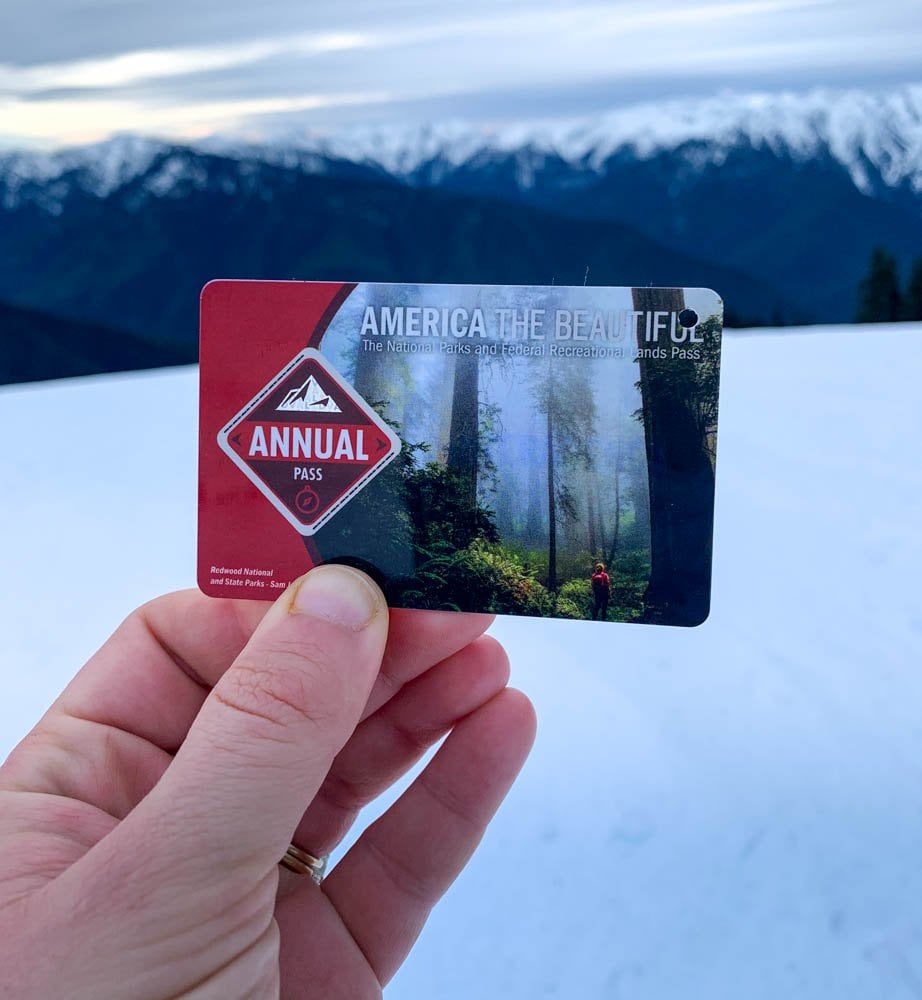
Sunrise is the second-most visited section of the park, behind the park’s aptly named Paradise section and its beloved fields of wildflowers and the Skyline Trail. And it’s no wonder why- this area is home to some of the absolute best hikes in Mount Rainier, like the Fremont Lookout and the Burroughs Mountain Trail.
Because of its popularity, starting in the summer of 2024, you are required to have a timed entry permit to enter the White River entrance from early July through early September, from 7:00 AM to 3:00 PM. You can learn more about these permits and how to get one for yourself on the National Park Service’s website.
Given the fact that you’ll be sharing a park entrance with the lots of other visitors who are headed to the Sunrise area, be prepared to wait in a serious line to get into the park, unless you show up on the earlier side (like, 9 AM or earlier). My husband, Justin, and I showed up to hike the Summerland Trail around 1 PM or so and were stuck waiting in a mile-long line for about an hour to enter the park. Laaaaaaaame.
Once you make your way to the trailhead, it’s also worth noting that parking is a bit more on the limited side, with about 20 or so parking spots by the trailhead and additional parking along the shoulder. Yet another good reason to get to the park on the earlier side- so you can snag a parking spot and don’t have to add on extra mileage to your hike!

When to Hike the Summerland Trail
The trail starts at almost 4,000 feet above sea level, so the trail usually has some serious snowfall, starting in late October and usually, lasting through June.
Come July, the snowmelt gives way to fields and fields of colorful wildflowers, swaying gently beneath Mount Rainier- and, on a less happy note, also lots of very persistent bugs (bring bug spray. Seriously). As summer wears on, the vibrant wildflowers will be replaced with ripe huckleberries, perfect for snacking on along the trail.
In my opinion, though, the best time to visit the Summerland Trail is in the fall. The park’s summer crowds (and the Mosquitoes from Hell) have blessedly subsided and the wildflowers around the trail have burst into brilliant shades of orange, gold, and scarlet. It’s jaw droppingly beautiful and seriously one of the best fall hikes in Rainier.

Just keep your eyes peeled for black bears, who are frantically trying to put weight on around this time of year for their winter hibernation, and keep a can of bearspray handy- we ran into lots of folks along the trail who saw bear friends while hiking.
Regardless of when you come, please be sure to stay on the trail and not wander around the meadows or otherwise step on the wildflowers. When most species of wildflowers are stepped on, they can’t produce seeds, which is generally how they reproduce.
So when you trample through the meadows to take that dreamy TikTok or whatever, you’re not just killing the current wildflowers, but also future generations of wildflower babies to come. And you don’t want to be a wildflower killer, do you? I don’t think so!

What to Expect Along the Summerland Trail
You’ll start the Summerland Trail in an old-growth forest, along a dirt path gently sloping upwards. About 0.25 miles into the trail, you’ll notice a junction to the right, where the path meets up with the Wonderland Trail, the incredibly epic-sounding 93-mile hike that circumnavigates the entire base of Rainier. If you happen to see Wonderland backpackers along the trail, show ‘em the mad respect that they deserve!
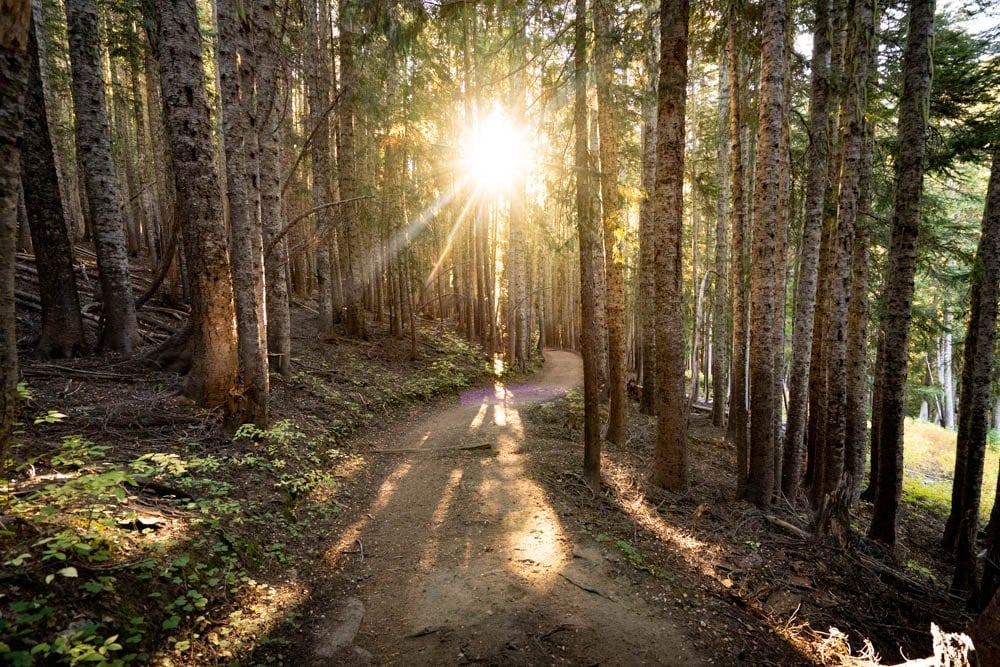
The trail eventually becomes steeper and starts following along closely to Fryingpan Creek. As you climb up deeper into the forest, there’s a few switchbacks where you can peer down over the cliffside to the creek’s icy rapids rushing below.
About three miles into the trail, the forest will open up a bit, with thick rhododendron shrubs surrounding the trail and dramatic views of the Cowlitz Chimneys, four craggy peaks that rise to the south, towering above.
At 3.2 miles in, you’ll need to hopscotch across Fryingpan Creek, partially on a log bridge and partially on large and slippery rocks. The log bridge feels like it’s a bit precariously placed on the edge of a small cliff, as the creek roars over and down the cliffside- it’s an excellent place to gape at the unusual milky white water and feel the cool air rush up at your face (so long as you’re not terribly uncomfortable with heights).
Once you’ve officially crossed the bridge, the trail truly becomes jaw-dropping, with Rainier looming ahead and, on all sides, vibrant shrubs and wildflowers, like Indian paintbrush, lupines, and avalanche lilies, carpeting the sloping hills around you. It’s really quite spectacular- so spectacular, in fact, that you won’t even notice that the trail has become quite a bit steeper!

Soon, the meadows will turn in much less exciting switchbacks along a forested hillside, rising about 500 feet in just 0.5 miles. Thankfully, these switchbacks will take you up to another open meadow and beyond, Little Tahoma (the adorably pointy little peak off Rainier’s eastern flank) and the snow-capped summit of Rainier itself.
Behind you, you’ll find Camp Summerland, a small campground with five campsites and one group site. The views here in Summerland are honestly worth the hike alone and you’ve got a good shot of spotting black bear and marmots in the surrounding open meadows.
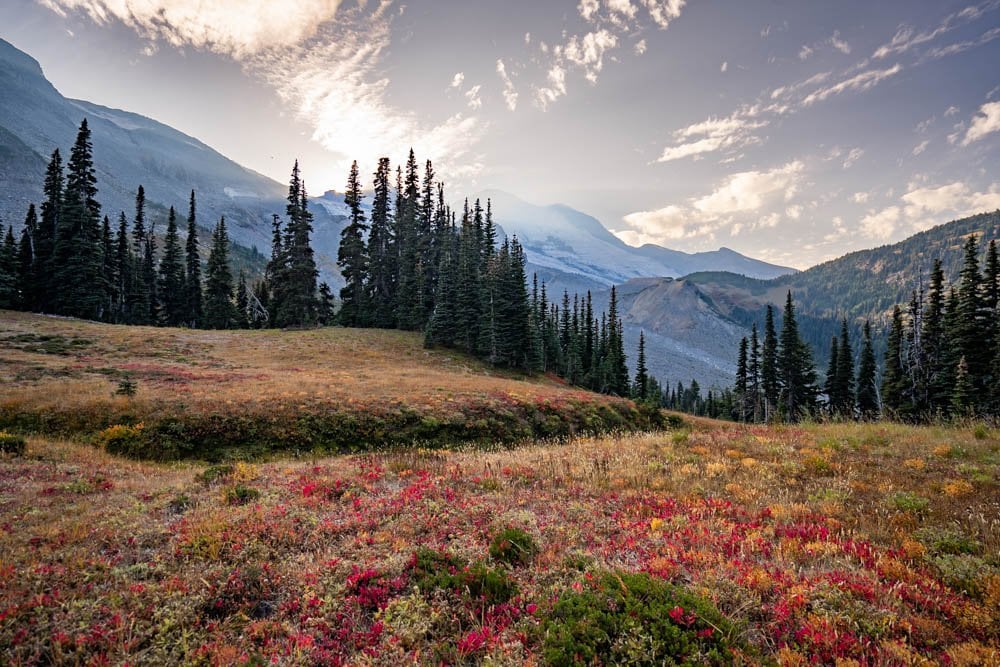
If you want to press on, though, you’re not done quite yet! The trail meanders on to Panhandle Gap, snaking through more meadows for about a quarter of a mile and transitioning into a rocky scree field.
The rest of the hike is along this rocky terrain, with gushing waterfalls, icy tairns, and, in the summertime, mountain goats galore.
Tip: This portion of the trail is a bit confusing to follow, so I'd recommend downloading an offline map of the trail on AllTrails before you head out in case you don't have cell service along the trail. You'll need the AllTrails+ version of the app to download offline maps, but, luckily, our readers can get a 7-day free trial PLUS 30% off their first year by using this link and the promo code "UPROOTED30" at checkout. If you're wondering whether the app is right for you, we wrote a whole post on whether AllTrails+ is worth it.
Along the way to Panhandle Gap, there’s a couple of stream crossings without a bridge and, depending on the level of snowmelt, the water level and current may make it challenging to figure out a way across. I’d highly recommend bringing along waterproof boots (like these for men or these for women) and a keen sense of adventure as you may have to ford across the stream during certain times of the year.
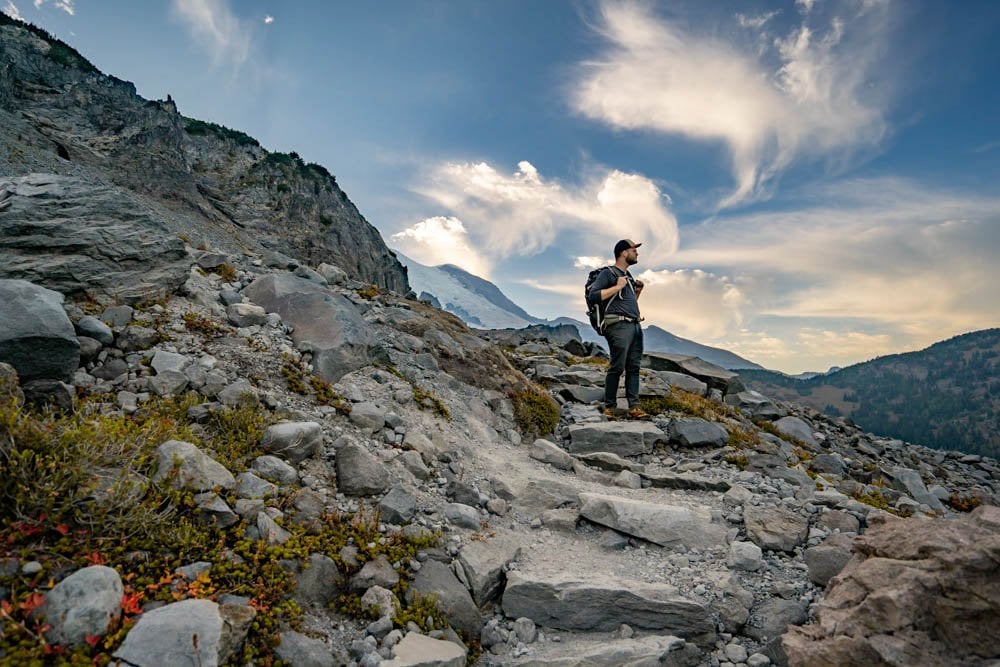
Towards the very end of the trail, you’ll pass two tairns, the first, green in color and the second, a stunning turquoise. Stop here to enjoy the reflections of Rainier in the calm water and marvel at the snowbergs that float about the water late into the season.
The final ascent to Panhandle Gap includes an incredibly steep slope that usually is covered with snow deep into the summertime. This portion of the trail should only be reserved for experienced hikers when it’s snowy or icy and trekking poles (and, perhaps, even an ice ax in the earlier summer) is a good idea.
Your ice axing efforts will be well worth it when you reach the top of the gap, with breathtaking views of Mount Adams, Goat Rocks, and even Mount Hood to the south and, of course, up close and personal views of Rainier.

If you’re camping at Summerland or just doing the Summerland trail as a day hike, you’ll turn back here, whereas Wonderland hikers will continue on the trail, past the gap to keep the Rainier adventures agoing.

Camping along Summerland Trail
As mentioned above, Camp Summerland is located about 4.5 miles into the trail, with five tent campsites, a group campsite, bear poles to hang your food (…sometimes, anyway- they were down when we camped there!), and a vault toilet.
Like all wilderness camping in Rainier, you’ll need a permit to camp here. And given that Summerland is arguably the most popular backpacking camp in Mount Rainier- I mean, just look at it!- you’ll need to try to snag a permit as early as you can, especially if you want to visit during a weekend.
After not winning Rainier’s early access lottery to make camping reservations before the general public, I got our Summerland permit at 7 AM the very first morning that permits became publicly available and, even then, the only Saturday that was still available was in the middle of October. So be sure to plan ahead- you can learn more about Rainier’s early access lottery and wilderness camping permitting process here.
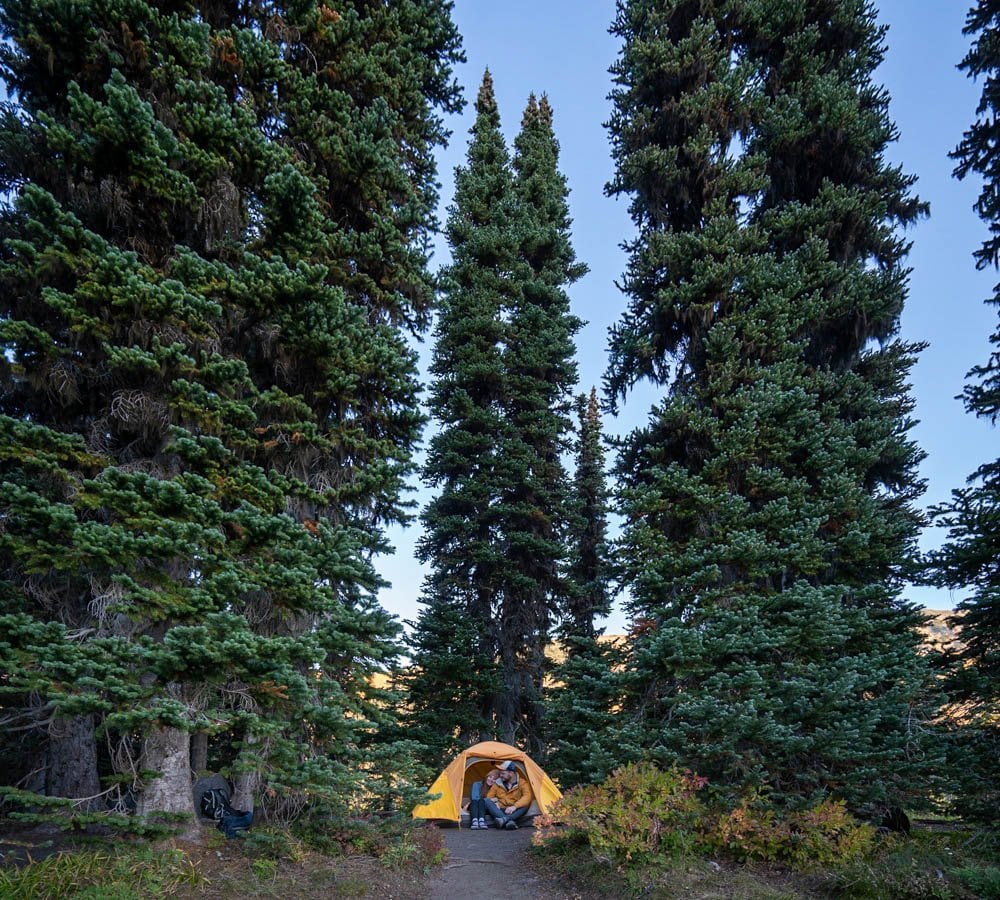
During our trip, we were stopped by a ranger on the trail to check our permit, so don’t attempt backpacking here without one!
Some other things to note about camping here:
- Be sure to check with the rangers before you head here to see if the bear poles are up or not while you’re camping. If not, you’ll need to bring a bear canister, both to protect your food from the hungry bears and to protect the bears themselves, who often have to be put down if they start to get a taste of human noms.
Make sure you also understand and practice good bear hygiene, like cooking your meals away from your tent and checking your backpack and pockets for errant wrappers and other food waste (I am the queen of having Clif bar wrappers in my backpack!).
- Campfires are prohibited; please respect that and all of the other Leave No Trace principles.
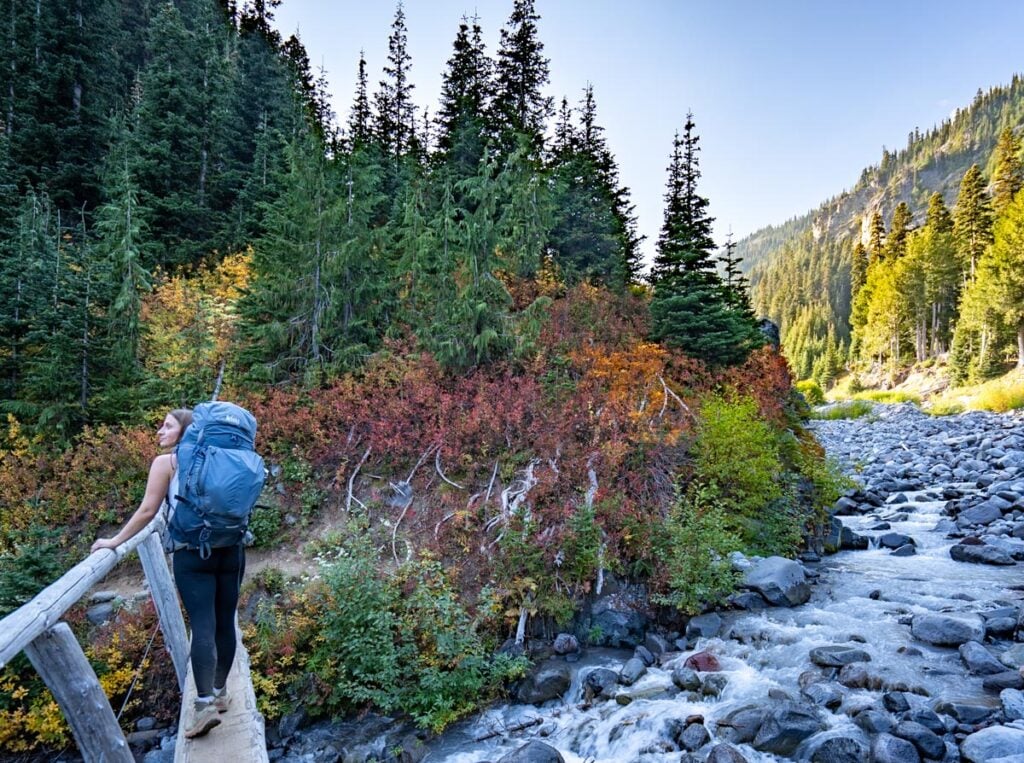
What to Pack for Camping Along the Summerland Trail
Not sure what to pack for backpacking here? Never fear- I gotchu!
- Your permit: You’ll pick this up in the park from one of the ranger stations and you’ll be asked to tie it to your backpack and, once you get to your campsite, your tent.
- America the Beautiful Pass: This will cover the cost of your park entrance fee and, occasionally, helps you get into the park faster when they open two entrance lines- one for folks who have to pay the entrance fee and one exclusively for pass-holders. It feels SO good when you get to bypass an enormous line!
- Tent: Justin and I have this one and we think it’s awesome. It looks like something straight out of a Wes Anderson movie, isn’t super heavy for the price point, and has huge vestibules to store your gear in.
- Sleeping bag: I have this one and Justin has this one. They keep us cozy, even in the mountains!
- Sleeping pad: I have this one and Justin has this one.

- Inflatable pillow
- Campstove: burner, propane canister, and lighter
- Cookware: We have this cook set, which comes with a lidded pot and two plastic cups and this larger steel cup with foldable handles, which perfectly fits around the cook kit and is perfect for holding things with a bit more volume, like chili.
- Folding camping sporks
- Water filter: There’s plenty of places to get water along the trail, so no need to pack a ton, so long as you have a water filter on hand.
- Refillable water bottle
- Portable single-serve pour over coffee: Who doesn’t love a cup of coffee in the morning?
- Bear spray
- Poop kit: The very scientific name for this kit, which you’ll need to use for, well, pooping in the woods. Bring along a lightweight trowel, toilet paper, and Ziploc baggies (to store used TP or feminine hygiene products).
- Large baggies to keep any food waste you create
- Food: Dehydrated meals (like this one or this one) are super convenient.
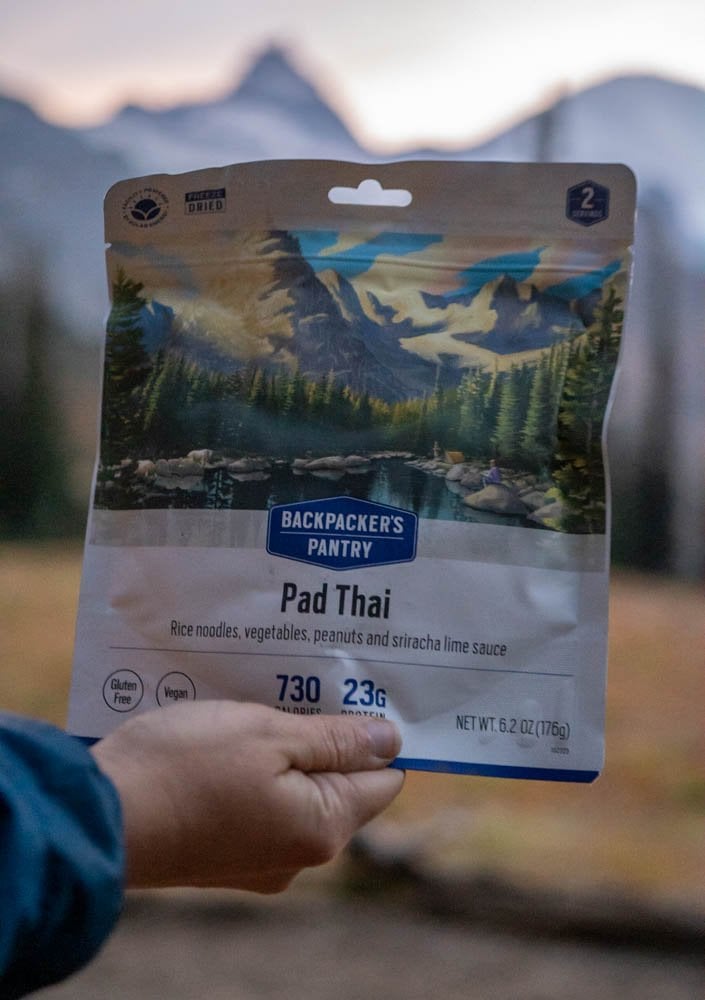
- Snacks: Gimme all thoseCool Mint Clif bars.
- Bear canister: To keep the aforementioned food and snacks
- Bugspray
- Sunscreen
- Toothpaste and toothbrush
- Rain jacket: This is Washington, y’all- rain is always a possibility (women’s and men’s).
- Phone, battery bank, and cords
- Headlamp
- Camera
- Waterproof hiking boots: There’s a ton of water crossings along this trail, many of which require you to walk in at least ankle-deep water- make sure they’re waterproof! I have these Topos and Justin has these.
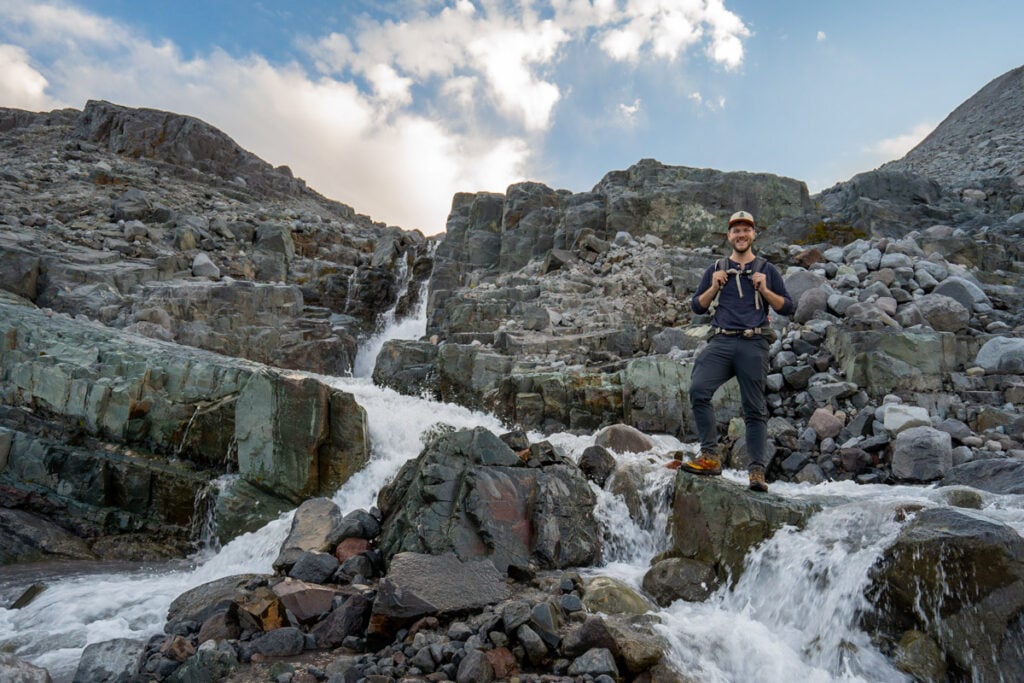
- Hiking sandals: Definitely not necessary or something you need to bring along if you’re conscious about weight, but I’m a comfort queen and love having something to slip into around camp as opposed to having to constantly take on and off my hiking boots. I love these sandals for women or these for men.
- First aid kit
If you need more guidance on what kind of items you should bring camping, be sure to check out our backpacking gear list for beginners.
Now, go forth and enjoy the Summerland trail, its fields of wildflowers, and all of its stunning views! If you have any questions about the hike, feel free to drop them in the comments below.
Thank you for reading our post! Check out our latest stories here and follow us on Instagram (@UprootedTraveler), YouTube, or on Facebook to see what we’re up to next!


